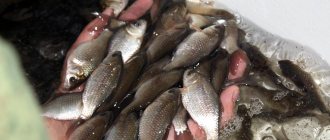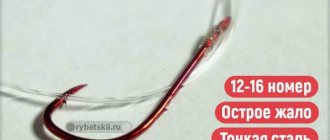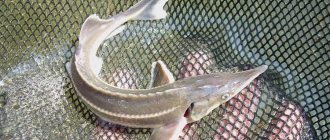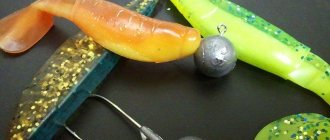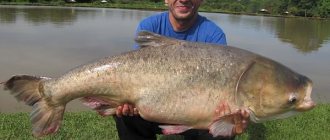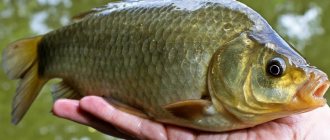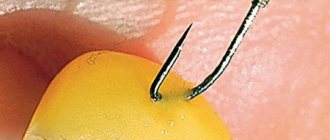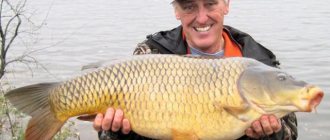Advantages and disadvantages of corn
Advantages:
- has high taste qualities;
- a characteristic smell that attracts the attention of fish;
- universal bait for many non-predatory inhabitants of water bodies;
- availability of bait for the entire fishing community;
- its bright golden color ensures good visibility for fish even in muddy water.
Flaws:
- if the corn is overcooked, it comes off the hook easily.
Large reservoir "Chernomorets". A group of amateur fishermen arrived at the pond to relax and fish. One fisherman had nothing with him except corn.
His colleagues laughed at him slightly, offering him their bait, peas, bread, maggots, and so on. He modestly refused the offer.
Fishing has begun. The water in the pond was cloudy. It rained heavily recently. Having thrown down the gear, everyone began to wait for the bite. After about 15 minutes, the bell at the tackle with corn rang and the rod bent. The hook and the line began to move from side to side. A carp weighing 2.5 kilograms was fished ashore.
This went on several times. My colleagues had 3 times less bites. Everyone wondered what was the matter. It turned out to be very simple. In the murky water, no bait other than corn was visible. Having changed their bait to corn, everyone began to fish for quite large specimens of carp.
Who likes a sweet dessert?
In addition to carp, you can catch other types of fish using corn. In ponds and lakes in central Russia, grass carp, tench and large crucian carp are often caught on a hook with this bait. On the river, it is appropriate to catch carp using corn; bream will not disdain the soft grain. You can tempt both roach and ide to bite with such bait.
In addition to carp fishing, this attachment can be used for feeder fishing for bream with its younger brothers: silver bream and sopa. Slowly falling aromatic grains during match or plug fishing can arouse the appetite of any member of the carp family. Interestingly, the predatory chub also bites on sweet grains.

Which corn to choose?
Choosing the right corn means ensuring good fishing. So which one should you choose?
Nozzle from a jar
Its features:
- sweet,
- soft,
- easy to put on the hook,
- It is easily removed from the hook, sometimes before reaching the water.
Boiled corn
Its features:
- not sweet
- It is quite difficult to put on the hook,
- hard to remove.
After analyzing the characteristics of bait of different preparations, we can conclude that boiled corn is more suitable for fishing. You just can’t digest it. Once overcooked, it becomes the same as in the jar.
Cook the corn for no more than 10 minutes. Then drain the water, pour the corn into a thermos or other tightly sealed container and close tightly. It is kept in the vessel until you arrive for fishing. After steaming, the corn becomes soft, but quite dense; small fish cannot remove it from the hook; it can only be swallowed.
How to prepare catchable corn for carp fishing
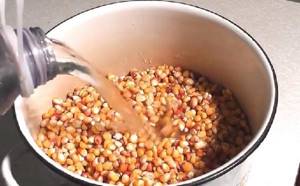
Corn for carp hunting is prepared in different ways. Fishermen have developed many recipes that allow them to obtain high-quality catchable bait that will not lose its taste and smell, retain its shape and consistency, and remain attractive to representatives of the ichthyofauna.
The most popular ways to prepare grains:
- cooking;
- fermentation;
- steaming;
- conservation.
Tip: If you don’t have the time or desire to prepare your own bait, you can use canned corn from any grocery store. The well-known “bonduel” works well, as well as specialized products from fishing brands (Carp Expert, traper, etc.)
Sometimes fishermen use silicone corn. This is an artificial nozzle that has positive buoyancy. It is rarely used as an independent bait, but it works quite well as a contrast bait.
Recommended reading: How to wash bloodworms
Boiled corn
One of the easiest ways to prepare bait is to process it in boiling water. The process is not complicated, but there are some nuances.
How to properly cook corn for carp fishing:
- To do this, take dry round-shaped grains, which are pre-soaked in warm water for a day or longer. Without soaking, the corn will also cook, but such bait will have a worse hold on the hook.
- After they swell and a characteristic white foam appears on top of the container, they are washed, filled with fresh water, and placed on the stove.
- Having brought the water to a boil, reduce the heat and leave the grains to simmer. They cook for about an hour, and you need to constantly monitor the density of the nozzle so that it does not boil over.
After cooking, cooked corn can be further flavored by treating it with an attractant.
A properly prepared bait, when pressed with your fingers, does not deform or wrinkle. It remains elastic and returns to its original shape. Store the nozzle in the refrigerator, preferably in an airtight cellophane package.
Fermented (drunk) corn
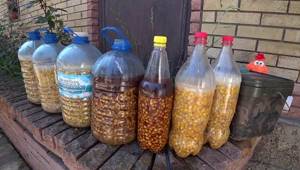
A good attachment, but it will require more time and effort to prepare. Among the advantages:
- a specific aroma that provokes carp to bite;
- fermented grains almost do not saturate the fish, which allows them to be used both as bait and added to bait;
- effective in cool water.
Poorly suited for hair rigs. But it holds perfectly on a regular single hook.
The recipe for making sour corn is simple, but time-consuming. Step-by-step instructions for fermenting bait:
- The grains are boiled for an hour over high heat.
- They are poured into their container, filling approximately 1/3.
- Fill with water, leaving 10–15% free space in the container.
- Add yeast at the rate of 10 grams per 1 kg of grains, and sugar - 3 tablespoons per 1 kg.
- Close the container tightly and place it in a dark place (closet, pantry, cellar).
- Fermentation begins after 3–4 days. After this, it is better to keep the future nozzle for 1–2 weeks without opening the container.
Recommended reading: How to prepare pearl barley for fishing
The resulting sour corn has a sharp, unpleasant odor to humans. All that remains is to drain the water, leaving a little so that the nozzle does not dry out. You can store it in the refrigerator for no more than two weeks, otherwise the bait may become acidic and lose its attractiveness to fish.
Large hook attachment
A distinctive feature of attaching corn to a large hook is that several grains, from 3 to 4, are placed on large hooks. The grains should be placed on large hooks only in the middle of its side part, so that the hook is completely hidden by the grains.
When using large hooks, the fisherman expects a bite from a large fish, so the bait on the hook should sit tightly, not allowing small things to pull it off. A large fish, sucking in the bait, swallows it completely and, while chewing the bait, clings to the hook.
Types of corn baits
All grains suitable for catching carp with corn can be divided into several categories:
- sweet food;
- steamed;
- fermented boiled;
- artificial;
- branded;
- fresh corn of milky ripeness.
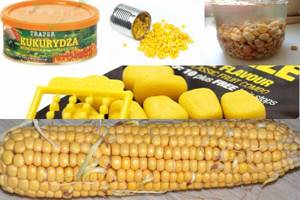
The term “candy food” refers to grains sold in grocery stores. The most popular brand is the well-known Bonduelle. Fishing with this type of corn is very popular because it is ready to hook, but is cheaper than branded baits.
Steamed and fermented baits are prepared with your own hands; they will be discussed in the next section.
Artificial corn is produced by fishing companies in the form of soft imitations of real grains. They are rich in a variety of aromas and attract fish well. Such artificial baits help when fishing on muddy bottoms, working as a floating boilie. In addition to natural grains, they can be attached to a hook or mounted on a hair rig.
Branded boiled is a ready-made product for catching carp with corn, produced by well-known and not so well-known companies that produce fishing lures. “Sensas”, “Traper”, “Sabaneev” - this is an incomplete list of manufacturers of such attachments.
You can also successfully catch carp or carp using fresh corn. Only it should be soft, barely reaching “milk” ripeness.
It is a pity that such bait is used only during the short period of ripening of this cereal crop.
Hair installation when planting corn
Features of this type of fishing tackle installation:
- used for catching large fish;
- only boiled corn is used as bait;
- In this type of tackle installation, the hook is not used for attaching bait.
The procedure for installing hair tackle
The hook is attached to the fishing line in such a way that a part of the fishing line, about 5 centimeters long, extends from its ring. A small loop is made at the end of this part of the fishing line.
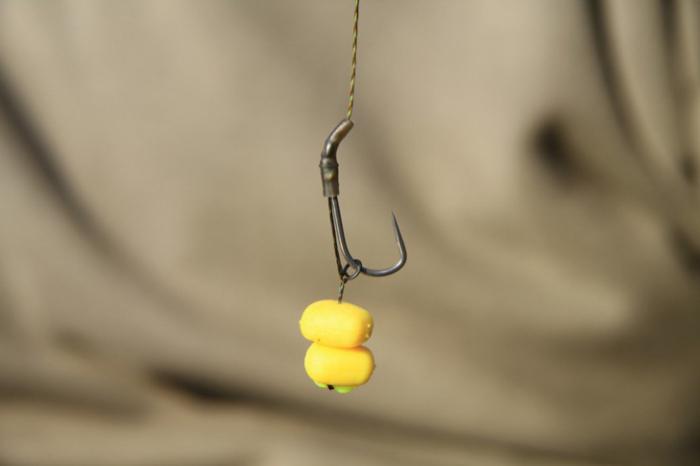
The fisherman must have a thin awl with a hook at the end. Put 5 – 6 grains of corn on the awl. They are put on through the center of the side of the grain.
The hook of the awl hooks onto the loop of the fishing line and pulls the corn from the awl onto the fishing line. The grains are attached to the fishing line with a stopper threaded through its loop. A small part of a toothpick can act as a stopper. That's it, the tackle is ready to be cast. As the fish sucks in the bait, it also sucks in the hook. When hooking, it catches the fish by the lower lip.
While fishing on the Chernomorets pond, 4 carp with a total weight of 11.6 kg, 3 tench - 3.4 kg, 2 grass carp each weighing 800 grams were caught using this type of gear.
Fishing with corn: what should the hook be?
However, before we talk about how to properly use corn as a bait, we also note that it is important to choose a hook. It should be thin and durable (made of high-quality steel), sharp (laser-sharpened or chemically sharpened) and inconspicuous (black, dark gray). Another requirement is that its shape helps hold the fish. If we speak “scientifically”, then the hook should have anti-slip geometry.

When using corn, you should choose the right hooks
If the angler ignores this, he risks that the carp will be confused by the bright body of the hook next to the bait. Or, when biting, the sting will not enter the fish’s strong lip, facilitating its escape. If the hook is made of low-quality steel, then it can easily break during the fishing process. It will be painful for the fish itself, and also sad for the fisherman who missed the carp. Therefore, be sure to use hooks from reliable manufacturers.
As for their size, no. 4-12 are suitable for catching carp with corn. Some anglers also use smaller No. 14 hooks. However, they are only good for small carp weighing up to 500 grams.
Single corn kernel attachment
A bait made from one grain of corn is used when fishing with a small hook. In this case, the plan is to catch small fish for fish soup.
Each fisherman has his own peculiarity of attaching corn kernels to the hook:
- through the edge of the grain;
- by his side;
- through the center of the side of the grain.
When baiting through the edge and side of the grain, the hook tip is not hidden. This type of bait is used for catching small crucian carp and roach.
When planting grain through the center of the side part, the tip of the hook that came out on the other side of the grain is hidden in its lower part. This type of bait is designed for catching larger fish.
Your own chef
There are two ways to prepare corn for fishing yourself: steaming and fermentation. Below are the recipes. Both recipes use ripe cobs, which can be stored for a long time. In addition to grain bait, you can also fish with hominy and corn porridge.
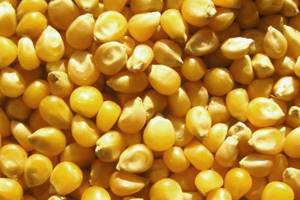
Before preparing the bait, the cobs must be cleaned and divided into individual grains. Carp like yellow old corn of late-ripening varieties, so it is advisable to use this kind. You can purchase cobs or threshed grain during harvest on farms.
Recipe 1: Steaming
- We soak the corn for a day, after filling it with warm water. It is advisable to change the water less than four times.
- Place the corn in a thermos so that the grains make up a quarter of the container.
- Add the desired flavoring to the thermos.
- Fill the remaining three-quarters of the volume with boiling water and close the thermos.
- After four hours the corn is ready.
Recipe 2: Fermentation
- Soak the grains for a day.
- Before cooking the grains, they need to be washed and sugar poured into a container at the rate of a tablespoon per liter.
- You need to cook for forty minutes to an hour. The grains should become soft, but not fall apart.
- We drain the water; by the way, it can be used for mixing bait.
- We transfer the grains into a bottle with a narrow neck, fill them with cold water and add flavorings, for example, honey works very well in such a nozzle.
- For better fermentation, add 10 grams of yeast per liter of water, or a glass of kefir.
- Mix everything thoroughly, shake it up, and then add a little vegetable oil so that its film does not allow air to pass through to the grains. We do not plug the throat so that the gases from fermentation can easily come out.
- After three to four days, fermentation is complete, you can extract the grains and go fishing. Store this attachment in a closed container in the refrigerator for no more than a month.
If you overexpose it a little, the grains will become sour, which sometimes gives a good effect when fishing with corn. During the fermentation process, the upper hard skin is destroyed, nutrients are released into the water, and the bait turns out to be soft, just like the king of our ponds, the carp, needs.
Recipe 3: hominy
- Mix corn and wheat flour in a ratio of three to one. Without wheat flour, hominy will not stick well to the hook.
- Gradually add water, stirring the contents constantly. The mixture should be as thick as good sour cream.
- Add and mix in aromatic additives: honey, vanilla, cinnamon, hemp and so on.
- Transfer the mixed mixture into a double plastic bag.
- Place the bag in a saucepan and add water so that it covers the bag.
- Cook the mamalyga for about thirty to forty minutes. If you need a soft nozzle, reduce the time, if hard, increase it.
- Turn off the stove and leave the hominy to cool right in the water.
We take the hominy to the fishing spot in the same double bag, and on the spot we roll it into balls or cut it into cubes with a knife.
It is also convenient to use hominy in feeder method fishing. Before casting, cover the feeder feeder with the mixture and bury the hook in it.
Place a few grains on a hook
This type of bait is used when fishing with a large hook and is designed to catch large fish. The methods for attaching corn to a hook, as in the first case, are varied. It depends on when the fisherman is luckier.
But analyzing the experience of catching large fish on corn, we can conclude that the most effective way to put several grains on a hook is through the center of the side of the grain.
Why?
- The hook is completely hidden, which does not scare the fish.
- The bait is difficult for small fish to pull off.
- Large fish, carp, carp, try to capture the bait entirely, dooming themselves to be hooked.
What method to put several grains on a hook is up to each fisherman.
What kind of corn can be used to catch carp?
Corn is considered an indispensable vegetable bait for carp fish, as it has the following advantages:
- When cooking corn, you can achieve the desired degree of softness or hardness of the grains.
- This type of attachment is several times cheaper than other artificial attachments.
- Almost any type of flavoring can be applied to corn, making it attractive to many types of fish.
- The corn is securely attached to the hook and does not dissolve in water.
- General availability of grains.
- It has an attractive aroma, color and shape, which is always very popular with most fish.
Disadvantages of using corn:
- A large amount of this complementary food can saturate the carp, after which it simply will not peck at the bait with the delicacy offered to it.
- Carp is not the only fish that doesn’t mind profiting from corn, so you can expect a bite from asp, bream, rudd and others, but this is more a plus than a minus.
To catch carp you can use the following types of corn:
- Store-bought canned (from a jar).
- Boiled.
- Young and fresh.
- Fermented.
Maggot and corn sandwich
How to properly bait a sandwich of maggots and corn? This type of bait is called a “sandwich” because it is formed from two types of bait.
It should be installed like this:
- maggots are planted first, 2 - 3 pieces;
- then corn grain;
- The bait is closed by another portion of maggots, 1 – 2 pieces.
All components of the bait must be placed on the side. Their number depends on the size of the hook and what kind of fish you plan to catch, large or not very large.
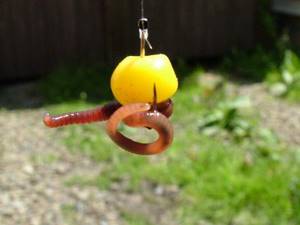
This type of bait is used when there is no active bite. In order to activate it, a “sandwich” is used. All types of non-predatory fish and some types of predators, chub, perch, go well with it.
Two friends were fishing on Medveditsa using a “Snake” fishing tackle, which had 4 leashes. They put a different bait on each leader; pearl barley, worm, grasshopper and corn and maggot sandwich.
Using the last type of bait, they caught several chubs, 400–500 grams each, and a large number of rudd. When we summed up the results of the fishing, it turned out that the fish bit on the “sandwich” almost 2 times more actively.
Blitztips
- In order to make the bait more natural, you should use both small and large corn grains at the same time;
- If you notice that the grain does not hold well on the hook, then there is no need to risk casting it, since it will still fly off when casting and there will be an “empty” hook in the water. You should immediately replace the spoiled grain with a new one;
- It is not recommended to use corn that was cooked more than three days ago as bait, as it will no longer have as strong a smell as fresh;
- It is advisable to store corn baits in tightly closed containers to prevent their specific aroma from eroding.
Advantages and disadvantages of fishing with corn
- What makes corn bait one of the best are its main advantages:
- affordable price;
- the opportunity to purchase a finished product and prepare it according to your own recipe in several ways;
- convenient and easy to string on a hook or hair rig;
- very attractive aroma, taste and color;
- catchable bait for carp and carp;
- versatility when hunting fish of various sizes;
- can be combined with other types of bait and flavorings;
- allows you to make bait of any degree of softness;
- holds securely on the gear.
- The disadvantages include:
- from abundant complementary feeding, carp and carp can get enough;
- will simultaneously attract other types of fish.
The versatility of the cereal vegetable can also malfunction, which will affect the catch.
Learn how to prepare potatoes for catching carp.
